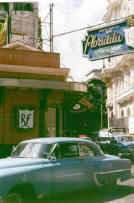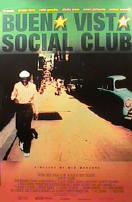Travels in Cuba (part 1 of 3)
Cigars, Salsa and Hemingway
There always has to be a mad taxi driver somewhere in the story. Ours arrived at the outset. Needless to say he was not the only one we encountered. Three o'clock in the morning on the way to Shannon airport and we were treated to hair-raising stories of gangland Limerick punctuated by expletives. Thirty minutes of this was almost enough to make us long for 8 hours on a cramped, stuffy aeroplane - almost! When we arrived at the airport it was like a scene from Stephen King's "IT". There were a few sleepy bodies strewn around on the seats in the Departure lounge but nothing was open. Finally at about five a.m. boarded the plane and started the journey to Cuba.
 Our
holiday began in Havana, the capital of Cuba. It's a bustling city, full of classic
cars, bike couriers and pedestrians. We started with a visit to a cigar factory,
to avoid the afternoon downpour, a result of visiting during the Rainy Season. The
Partagas Factory is located in the centre of the city. The guide took us through
the cigar-making process from the sorting of the outer leaves to the grading of
the four interior leaves that make up a cigar. One of the leaves is for flavour,
one for smell, one for burning and one for binding. The combinations or recipes
of these four leaves make up the different brands - Cohibas, Romeo and Juliettas,
Bolivars, Montecristos. The factory is like most buildings in Cuba, old and crumbling
both inside and out. Nothing is automated and bare hands, sweat and skill combine
to make the cigars. There is a 9-month training school before the workers are allowed
roll cigars and every person is responsible for a certain brand. They are checked
at every stage. The room also has a table at one end where newspapers are read out
in the morning and books in the afternoon. There was thunder and lightening outside
while we were visiting and lots of cheers when the electricity flickered with the
prospect of getting home early should it fail altogether. All of it is so new to
the workers they still treat visitors with a sense of awe and interest. However
it won't be long before they become jaded by streams of people coming in and staring
at them.
Our
holiday began in Havana, the capital of Cuba. It's a bustling city, full of classic
cars, bike couriers and pedestrians. We started with a visit to a cigar factory,
to avoid the afternoon downpour, a result of visiting during the Rainy Season. The
Partagas Factory is located in the centre of the city. The guide took us through
the cigar-making process from the sorting of the outer leaves to the grading of
the four interior leaves that make up a cigar. One of the leaves is for flavour,
one for smell, one for burning and one for binding. The combinations or recipes
of these four leaves make up the different brands - Cohibas, Romeo and Juliettas,
Bolivars, Montecristos. The factory is like most buildings in Cuba, old and crumbling
both inside and out. Nothing is automated and bare hands, sweat and skill combine
to make the cigars. There is a 9-month training school before the workers are allowed
roll cigars and every person is responsible for a certain brand. They are checked
at every stage. The room also has a table at one end where newspapers are read out
in the morning and books in the afternoon. There was thunder and lightening outside
while we were visiting and lots of cheers when the electricity flickered with the
prospect of getting home early should it fail altogether. All of it is so new to
the workers they still treat visitors with a sense of awe and interest. However
it won't be long before they become jaded by streams of people coming in and staring
at them.
Our next trip was to Hemingway's house outside the city. This was our first journey into the countryside and it was unlike anywhere I'd ever been. People line the roads hitchhiking and all shapes and sizes of cars and motorbikes speed past. Hemingway's house is situated overlooking the village of San Francisco de Paula, shaded by Palm trees and a respite of calm after the drama of Havana. The house is available to the public to look through the open windows and doors and wander in the grounds. It is left exactly as it was when Hemingway lived there and is filled with his books, music and his collection of African memorabilia. The pool is empty but the feeling as you walk down the shaded path to it is eerie. You can almost feel the presence of the great writer and imagine the poolside parties when he entertained Ava Gardener and Gary Cooper. Nearby is the fishing village Coj?ar, the setting for his Noble Prize winning novel "The Old Man and the Sea". It's a pretty village and the restaurant "La Terraza" was once a favourite haunt of his. The Hemingway trail continued back to Havana where there are a number of drinking establishments frequented by the famed writer - The Ambos Mundos Hotel, La Floridita (great but pricey daiquiris) and La Bodeguita del Medio, probably the most expensive place we drank in Cuba.
 One
of the best things about a holiday in Cuba and Havana in particular is the music.
It carries you away on a swirling fantasy ride with trombones, trumpets and beating
drums. The impact of the Buena Vista Social Club film and music is not to be underestimated.
A lot of the bands in the various bars and clubs play the most renowned songs from
the album. It's hard to describe the atmosphere in the streets as you walk along
in the balmy evening, it's hot and sticky and the heart of the city beats all around
you.
One
of the best things about a holiday in Cuba and Havana in particular is the music.
It carries you away on a swirling fantasy ride with trombones, trumpets and beating
drums. The impact of the Buena Vista Social Club film and music is not to be underestimated.
A lot of the bands in the various bars and clubs play the most renowned songs from
the album. It's hard to describe the atmosphere in the streets as you walk along
in the balmy evening, it's hot and sticky and the heart of the city beats all around
you.
Further along the southern coast of the Island is the town of Trinidad. The nearby beach is Playa Ancon and it is frequented by tourists and Cubans alike. We went snorkelling and it was a great experience, very safe with fish of a myriad of colours. I hadn't done it before but am hooked (excuse the pun). There are plenty of facilities in the beachfront hotel, it has an outdoor pool and restaurants both on the sea front, and indoors. There are pedal boats and kayaks for hire on the beach. The town of Trinidad is easy to explore on foot and the cobbled streets and red roofed houses make it very picturesque. It has an old world charm and sleepier pace than Havana. The museum in the main town square is worth a visit as is the tower a few metres away which provides beautiful views of the surrounding hills. The nightlife is geared towards tourists but we loved the outdoor bands at the Casa de La Musica. One of the highlights of our trip was a salsa class in a Cuban woman's home. She had an electric fan on the floor, a battered old ghetto blaster and the room looked out onto banana trees in the garden. She kicked off her shoes and showed us the basic salsa steps. My eyes were stinging as beads of perspiration trickled down my face. We must have looked hilarious, 40-degree heat and the four of us dancing wildly around the room. She even brought out two little girls to help us dance. Needless to say we had trouble keeping up. They were about five and seven years old and had all the moves off perfectly, it was embarrassing with our two left feet. She explained that Cubans dance with their whole bodies not just their feet and you have to feel the passion to do it properly. It's not quite the same as traditional Irish dancing!
>> Continue with part 2
